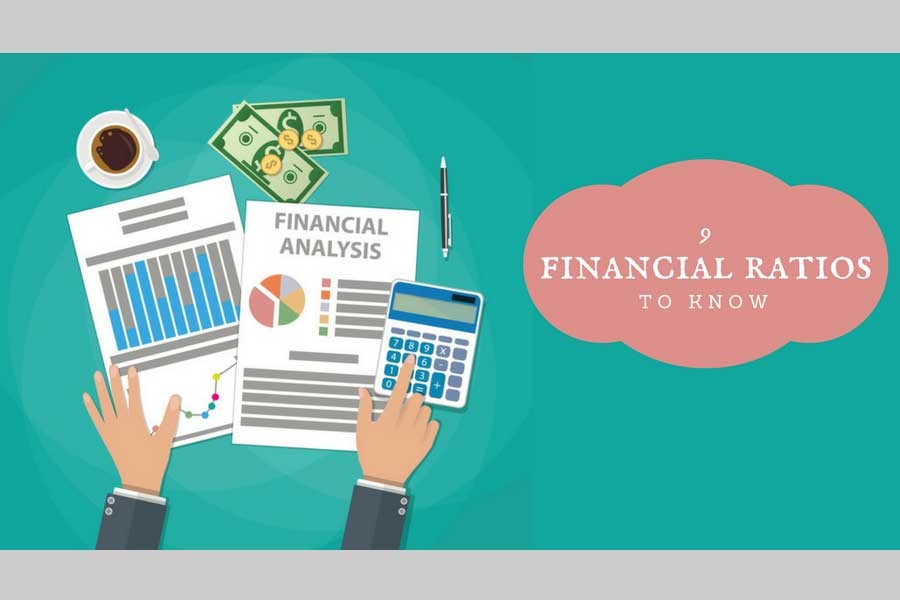Financial ratios are the key to understand how a company performs. We will discuss five valuable financial ratios that every investor must know. Many of us probably heard about some of them, but let's see what these ratios really mean and indicate.
Ratio no. 01: EPS: EPS stands for earnings per share which indicates profitability of the company. From the prospective of an investor, it's always better to invest in a company with higher EPS as it means that the company is generating greater profits. Also, before investing in a company, an investor should check it's EPS for at least last 5 years. If the EPS is growing for these years, it's a good sign to invest and vice-versa.
Example: Company ABC has a total of 100 outstanding shares, the company announces preferred dividends of $2.50 and they have made a profit of $80 in the financial year 2017. What is the EPS of company ABC? Here, EPS = [($80 (profits) - $2.50 (preferred dividend)]/100 (no. of outstanding shares)]. Hence, EPS will be $0.78/share which is a portion of profit that belongs to one share.
Ratio no. 02: (P/E): P/E stands for price to earnings ratio which indicates the market value of a stock as compared to the company's earnings. P/E ratio shows what the market is willing to pay today for a stock based on its past or future earnings.
Example: Company ABC's stock is currently trading at $8 and EPS per share for the year is $0.78. Hence, P/E ratio is just the price (selling price $8/0.78 EPS) i.e. $10.25 which means an investor will have to pay $10.25 to get back $1 yearly from the company. A stock with low P/E ratio is considered as cheap but it must be remembered that it doesn't mean an investor should buy the share carelessly.
Ratio no. 03: (D/E): D/E stands for debt to equity ratio which gives an idea of the company's debt compared to the total value of its stock while investing in a company. Generally, a high debt company will often be in trouble during hard times and a lower debt company stays on a safer side. Also, it should be kept in mind that high leveraged company can also do good if they manage their lever efficiently.
Example: Company ABC has a total $300 line of credit and total value of its stocks is $800 (100*8). Hence, debt to equity ratio will be $300/800= $0.375 which indicates company ABC has leveraged $0.375 against holding stock of $1.
Ratio no. 04: (P/B): The P/B (price to book) ratio is used to compare a company's net assets available to common shareholders relative to the sale price of its stocks. And book value means the amount recorded and companies calculate it netting the assets against its accumulated depreciation which can be found on a company's balance sheet. In general, accountants prefer to deal with costs rather than with values. In short, it is the net worth of the company.
A ratio over one indicates that the market is willing to pay more than the equity per share and a ratio under one indicates that the market is willing to pay less.
Example: Company ABC has $150 in assets like property, plant, equipment, cash etc and the company has $100 in debt. Hence, the book value of the company will be assets- debts ($150-$100)= $50.
We have got book value i.e. $50 and price per share was $10.25 from our previous example. Hence P/B ratio will be [(Market Price Share ($10.25)/Book Value per share ($50)] equals to $0.21 which indicates company ABC is selling at 0.21 the price of its net worth.
Ratio no. 05: (ROE): The final ratio of our discussion is ROE (return on equity) which is extremely useful while analysing companies showing the return an investor will get from profits in terms of percentage. And ROE can be calculated by (Net Income/No. of equity shares)*100.
Example: Recap from previous example, net income was $80 and company ABC has a total of 100 equity shares. As such, ROE will be ($80/100)*100 = 80%. A higher ROE means the company is performing well; usually investor will aim for ROE greater than 15%.
Md Harun-Or-Rashid is a banker and certified finance specialist. [email protected]


